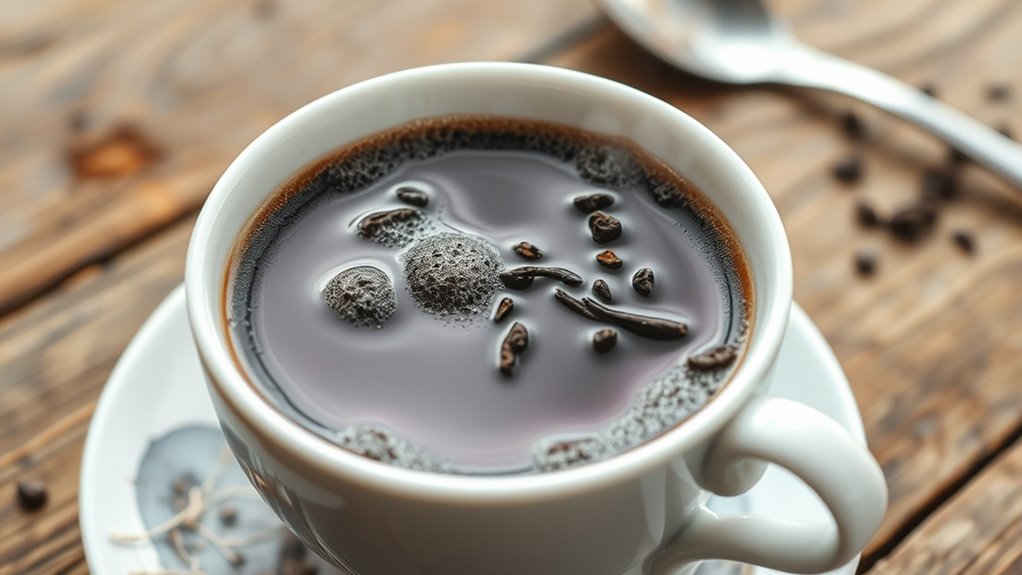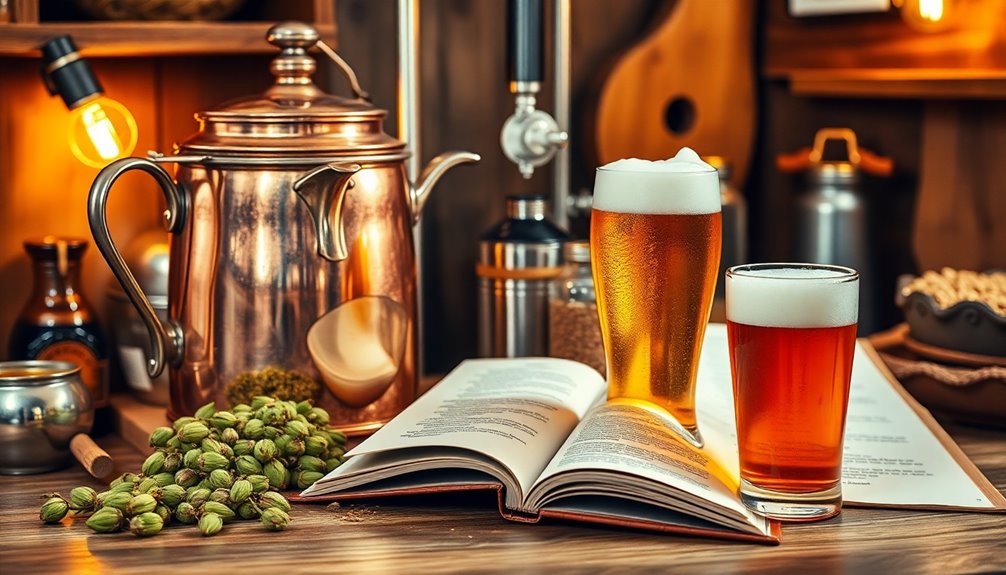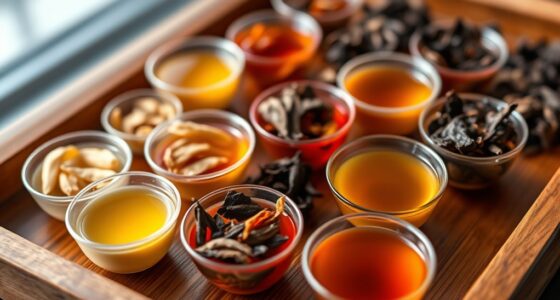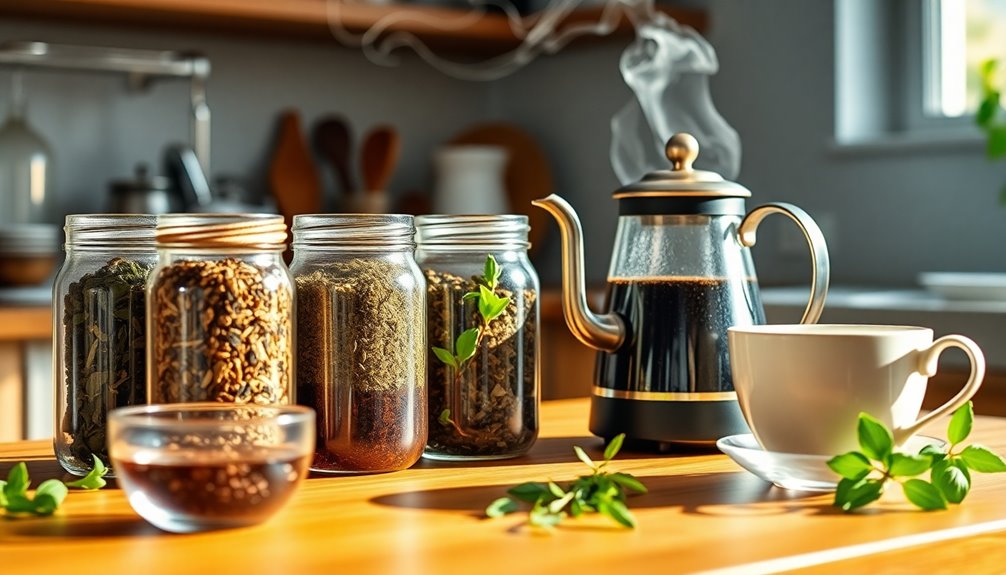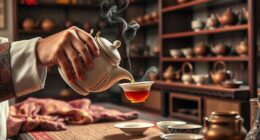If your tea tastes bitter, you might be overdoing it with steeping time or using water that’s too hot, especially for delicate teas. Leaving the leaves in the water too long or pouring boiling water can extract harsh compounds like tannins, making the brew bitter. Using low-quality leaves or not removing them promptly also worsens this. Keep your brewing techniques in check, and you’ll enjoy a smoother cup—learn more tips for perfecting your tea.
Key Takeaways
- Using water that’s too hot for delicate teas causes over-extraction and bitterness.
- Steeping for too long releases excessive tannins, resulting in a bitter taste.
- Leaving tea leaves in the water after steeping continues extraction and increases bitterness.
- Poor-quality tea leaves tend to release bitter compounds more easily when brewed improperly.
- Ignoring recommended brewing times and temperatures leads to over-infusing and a harsh flavor.
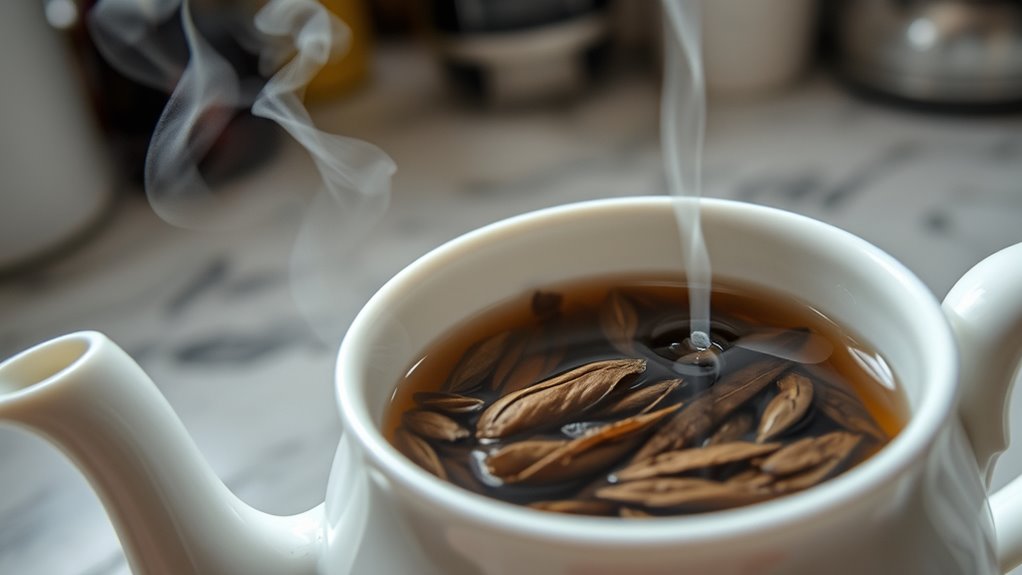
If your tea tastes bitter, it’s often because of how you’re brewing it or the type of tea you’re using. One of the most common causes is improper water temperature. Different teas require specific water temperatures to *discover* their best flavors without extracting excess tannins, which lead to bitterness. For delicate green or white teas, using water that’s too hot can quickly turn a smooth sip into a harsh, bitter experience. Ideally, green teas should be brewed with water around 160-180°F (70-80°C), while black teas can handle closer to boiling point, about 200-212°F (93-100°C). If you’re unsure, invest in a good thermometer or kettle with temperature control. Avoid pouring boiling water directly onto more delicate teas, as this often results in over-extraction, causing bitterness.
Steeping time also plays a *vital* role in the bitterness of your tea. Leaving your tea leaves in hot water for too long will extract a surplus of tannins and polyphenols, which are responsible for that unwanted bitter flavor. Each type of tea has an *ideal* steeping window. For instance, green teas generally steep for 2-3 minutes, while black teas can go up to 3-5 minutes. If you exceed these times, the tea becomes overly infused, pulling out bitter compounds that overshadow the nuanced flavors. To avoid this, set a timer when steeping and stick to the recommended duration. If you prefer a stronger brew, it’s better to start with a shorter steep and then add more water or steep again, rather than extending the original time.
Another common mistake is neglecting to remove the tea leaves promptly after the steeping time is up. Leaving them in the water continues to extract flavors, often turning the brew bitter. Use a strainer or an infuser to take out the leaves once your timer ends, and pour the tea into your cup. Additionally, pay attention to the quality of your tea leaves. Lower-quality leaves tend to release bitter compounds more easily when brewed improperly. Investing in good-quality loose leaf tea and following the recommended brewing guidelines can make a *noticeable* difference in taste.
Frequently Asked Questions
Does the Type of Tea Leaf Affect Bitterness?
The type of tea leaf definitely affects bitterness because different leaf processing methods create distinct flavor profiles. For example, green tea leaves are minimally processed, often resulting in a lighter, fresher taste, while black tea leaves undergo oxidation, which can add a richer, sometimes more bitter flavor. Your choice of tea leaf impacts the overall flavor, and understanding these processing differences helps you brew a more balanced, enjoyable cup.
Can Adding Milk Reduce Tea Bitterness?
Adding milk can reduce tea bitterness by mellowing sharp flavors and providing flavor masking. When you add milk, the proteins bind to bitter compounds, softening the overall taste. This simple step helps you enjoy a smoother, less astringent tea experience. Just be mindful not to add too much, as it can overpower delicate flavors. A splash of milk is often enough to balance out bitterness effectively.
How Does Water Quality Influence Tea Taste?
You should consider how water quality influences your tea taste. Water mineral content, especially high levels of calcium or magnesium, can make your tea taste dull or bitter. Using proper filtration methods, like activated charcoal or reverse osmosis, can remove impurities and improve flavor. Clean, soft water enhances the tea’s natural aroma and sweetness, making each brew more enjoyable and reducing bitterness caused by mineral overload.
Is It Better to Brew Tea Multiple Times?
Did you know that most teas can be brewed multiple times without losing flavor? It’s better to reuse your tea leaves, especially if stored properly in an airtight container away from light. When brewing again, adjust the temperature to avoid bitterness. Proper tea storage preserves aroma and quality, making subsequent brews more enjoyable. So, yes—reusing tea leaves is efficient, but pay attention to brewing temperature for the best taste.
Does the Shape of the Teapot Matter?
The shape of your teapot does matter, especially for brewing the perfect cup. A teapot’s material, like clay or glass, influences heat retention and flavor extraction. Additionally, your pouring technique impacts how evenly the tea brews and prevents bitterness. Choose a shape that suits your tea type, and pour gently to avoid agitation. This way, you guarantee your tea’s flavor is balanced and enjoyable every time.
Conclusion
So, next time your tea turns bitter, remember it’s often just a brewing mistake. For example, Sarah brewed her green tea for too long and ended up with a harsh taste. By adjusting her steeping time and water temperature, she finally enjoyed a smooth, flavorful cup. Pay attention to these small details, and you’ll turn every brew into a delightful experience, avoiding bitterness and truly savoring your tea.

